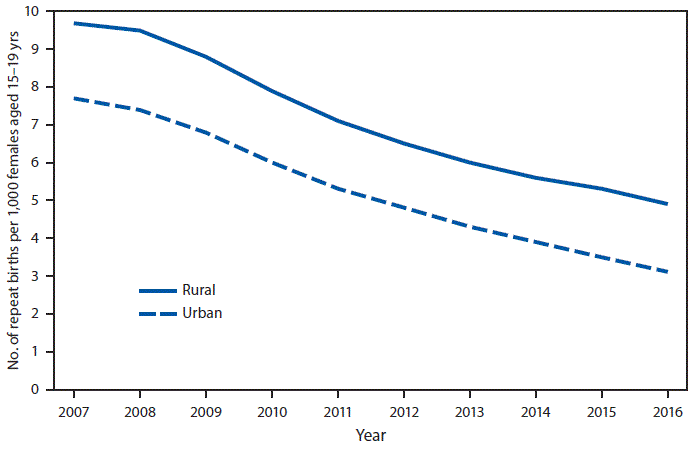QuickStats: Repeat* Birth Rates for Teens,† by Urbanization Level of County§ — National Vital Statistics System, 2007–2016
Weekly / September 7, 2018 / 67(35);998

* Repeat births are second and higher-order births. Birth order refers to the number of children born alive to the mother. Births recorded with no birth order stated are proportionately distributed across birth order categories.
† The number of repeat births to females aged 15–19 years per 1,000 females aged 15–19 years.
§ Urbanization level is based on maternal county of residence. Counties were classified according to their metropolitan status using the National Center for Health Statistics Urban–Rural Classification Scheme. https://www.cdc.gov/nchs/data_access/urban_rural.htm.
From 2007 to 2016, the rate for repeat births for females aged 15–19 years significantly declined in both rural and urban counties. Repeat birth rates declined 49% in rural counties (from 9.7 in 2007 to 4.9 in 2016) and 60% in urban counties (from 7.7 in 2007 to 3.1 in 2016). However, the rate in rural counties was significantly higher than the rate in urban counties for each year from 2007 through 2016.
Source: National Vital Statistics System, Natality, 2007–2016. https://www.cdc.gov/nchs/nvss/births.htm.
Reported by: Brady E. Hamilton, PhD, boh5@cdc.gov, 301-458-4653; Danielle M. Ely, PhD.
Suggested citation for this article: QuickStats: Repeat Birth Rates for Teens, by Urbanization Level of County — National Vital Statistics System, 2007–2016. MMWR Morb Mortal Wkly Rep 2018;67:998. DOI: http://dx.doi.org/10.15585/mmwr.mm6735a7.
MMWR and Morbidity and Mortality Weekly Report are service marks of the U.S. Department of Health and Human Services.
Use of trade names and commercial sources is for identification only and does not imply endorsement by the U.S. Department of
Health and Human Services.
References to non-CDC sites on the Internet are
provided as a service to MMWR readers and do not constitute or imply
endorsement of these organizations or their programs by CDC or the U.S.
Department of Health and Human Services. CDC is not responsible for the content
of pages found at these sites. URL addresses listed in MMWR were current as of
the date of publication.
All HTML versions of MMWR articles are generated from final proofs through an automated process. This conversion might result in character translation or format errors in the HTML version. Users are referred to the electronic PDF version (https://www.cdc.gov/mmwr) and/or the original MMWR paper copy for printable versions of official text, figures, and tables.
Questions or messages regarding errors in formatting should be addressed to mmwrq@cdc.gov.